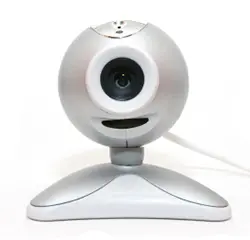A webcam hack is nothing special. It’s just plain-old malware.
Some malware acts as spam-sending zombies. Other malware actually performs data destruction. Still other malware might sniff your keystrokes. This malware turns on your webcam and does something with what it sees.
Let’s look at how this works and what you can do.
The nature of malware
Malware hides.
Malware does everything it can to hide itself. Think of those keystroke loggers, spam-sending botnets, or any of those other forms of malware that are typically not visible, and particularly not visible on the screen.
Perhaps when you use your webcam normally you see software running ont the screen, but all bets are off if malware is involved. You may never see the webcam software running because the webcam’s being run by malware.
Look for the light
 On most webcams, you should see a light on or near the camera when it’s turned on. It’s normally implemented in hardware: when the camera goes on, the light should go on, too.
On most webcams, you should see a light on or near the camera when it’s turned on. It’s normally implemented in hardware: when the camera goes on, the light should go on, too.
However that approach is not a requirement. The light might, in fact, be under the control of software. The webcam driver may have code that says if the camera is on, show the light.
If that’s the case, it’s possible that malware won’t be so polite. If the two functions can be separated, the malware could turn on the camera without turning on the light.
As trite as is sounds the bottom line to all this is to just avoid malware.
Do all of the things that you know will keep your machine safe and malware-free. Do this and a webcam-hacking malware shouldn’t be an issue.

It’s usually done with what is called a Remote Access Tool or RAT. Like many (or most) technologies, they have a legitimate use but shady people will use them for nefarious purposes. Type “ratting computers” into YouTube to see what I mean.
A good explanation can be found here.
https://deeppoliticsforum.com/forums/showthread.php?11528-Remote-Administration-Tool-(RAT)
Leo’s advice is sound as ever. Avoid the problem in the first place 🙂
However – some low-tech solutions….
If it’s a separate webcam, simply unplug it when you don’t want to use it.
If it’s built into the monitor (like almost all laptops these days) cover it with something. This may or may not work with the microphone as well – if they are hacking into the vision, they may well be getting the sound too.
On a different note, I have seen references to this used as a scare tactic in messaging programs – a ‘stranger’ implies they have access to your cam when in fact they don’t (they gamble that you actually have a cam connected)
I have a logitech that has a slider cover for the camera so although I also keep my anti-malware and anti-virus up to day, my low tech solution is to just keep it closed when not in use.
Another issue: A plethora of Trendnet webcams have a severe insecurity that allows anyone to surf to the computer’s IP address and watch what’s going on. No malware necessary. http://www.theverge.com/2013/1/22/3902698/trendnet-security-camera-streams-mapped-out